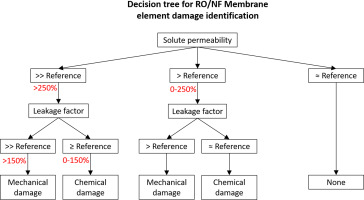当前位置:
X-MOL 学术
›
Desalination
›
论文详情
Our official English website, www.x-mol.net, welcomes your feedback! (Note: you will need to create a separate account there.)
Reverse osmosis membrane element integrity evaluation using imperfection model
Desalination ( IF 9.9 ) Pub Date : 2020-02-01 , DOI: 10.1016/j.desal.2019.114175 Claudia Niewersch , Christopher Rieth , Leaelaf Hailemariam , Guillem Gilabert Oriol , Justyna Warczok
Desalination ( IF 9.9 ) Pub Date : 2020-02-01 , DOI: 10.1016/j.desal.2019.114175 Claudia Niewersch , Christopher Rieth , Leaelaf Hailemariam , Guillem Gilabert Oriol , Justyna Warczok

|
Abstract The operational efficacy of membrane separation processes such as reverse osmosis (RO) and nanofiltration (NF) can be compromised by the lack of mechanical or chemical integrity of the membrane element. Currently, there are several methods applied to analyse membrane and membrane element integrity. However, given that most of them are somewhat inaccurate, expensive or time consuming, the motivation of this study was to implement a simple model-based evaluation method for a single element. The approach was built based on the solution-diffusion-imperfection model and its subsequent revised versions of this model. The models were fitted to experimental data obtained for three types of elements: new, damaged under controlled laboratory conditions and damaged during full scale operation. Based on the experimental results and the fitting of two model parameters, which are the leakage factor and the solute permeability, a criterion for diagnosis of the damage type was formulated. The results confirm the applicability of the modeling approaches. Finally, a decision tree is presented with the aim to help the plant operator to diagnose the type of damage the membrane element suffers.
中文翻译:

基于缺陷模型的反渗透膜元件完整性评价
摘要 反渗透 (RO) 和纳滤 (NF) 等膜分离工艺的运行效率会因膜元件缺乏机械或化学完整性而受到影响。目前,有几种方法可用于分析膜和膜元件的完整性。然而,鉴于它们中的大多数都有些不准确、昂贵或耗时,本研究的动机是对单个元素实施一种简单的基于模型的评估方法。该方法是基于解决方案-扩散-缺陷模型及其随后对该模型的修订版本而构建的。这些模型适用于为三种类型的元件获得的实验数据:新的、受控实验室条件下损坏的和在全尺寸操作期间损坏的。根据实验结果和泄漏因子和溶质渗透率两个模型参数的拟合,建立了损伤类型的诊断标准。结果证实了建模方法的适用性。最后,提供了一个决策树,旨在帮助工厂操作员诊断膜元件遭受的损坏类型。
更新日期:2020-02-01
中文翻译:

基于缺陷模型的反渗透膜元件完整性评价
摘要 反渗透 (RO) 和纳滤 (NF) 等膜分离工艺的运行效率会因膜元件缺乏机械或化学完整性而受到影响。目前,有几种方法可用于分析膜和膜元件的完整性。然而,鉴于它们中的大多数都有些不准确、昂贵或耗时,本研究的动机是对单个元素实施一种简单的基于模型的评估方法。该方法是基于解决方案-扩散-缺陷模型及其随后对该模型的修订版本而构建的。这些模型适用于为三种类型的元件获得的实验数据:新的、受控实验室条件下损坏的和在全尺寸操作期间损坏的。根据实验结果和泄漏因子和溶质渗透率两个模型参数的拟合,建立了损伤类型的诊断标准。结果证实了建模方法的适用性。最后,提供了一个决策树,旨在帮助工厂操作员诊断膜元件遭受的损坏类型。



























 京公网安备 11010802027423号
京公网安备 11010802027423号